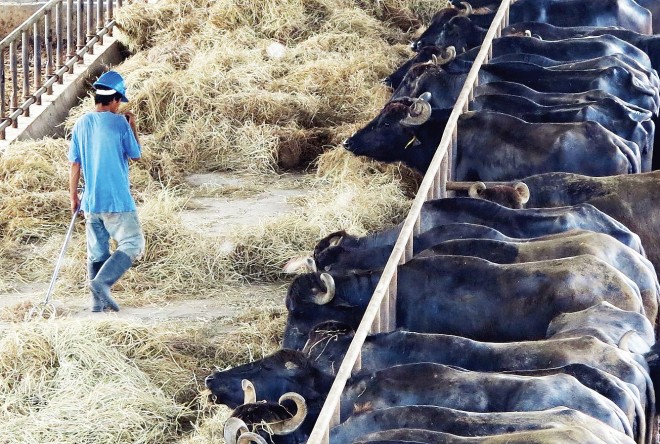
PHILIPPINE Carabao Center scientists are busy improving the carabao stock to ensure improved breeds for future generations. EV ESPIRITU/INQUIRER NORTHERN LUZON
SCIENCE CITY OF MUÑOZ, Philippines— The “reengineering” of the carabao is a huge showcase of development in science and technology, making up for centuries of neglect that these beasts of burden have suffered while helping Filipinos produce food.
Barefoot technicians, more formally known as village-based artificial insemination technicians, have been helping the countryside spawn “upgraded carabao,” using technologies taught to them by the Philippine Carabao Center (PCC).
Farmers now regard their upgraded carabao as their “beasts of fortune.”
Take the case of Pablo Nazar of Talavera town, Nueva Ecija province. When his daughter was diagnosed with lupus, Nazar leased out his 2-hectare farm for P400,000 instead of selling his upgraded carabao to finance her medical needs.
The upgraded carabao had started to produce milk, so Nazar considered these animals his “remaining hope.” Their number increased and his 2-ha farm was redeemed, although his daughter passed away.
In Magalang town, Pampanga province, Andipoe Garcia upholds the “superbness” of his 12-year-old crossbred, a product of the crossbreeding between a native carabao and a Murrah buffalo breed.
“It yields 14 liters of milk a day for three months; in other months, 7 to 8 liters a day,” Garcia said. He has 36 other dairy crossbreds, though these yield less milk.
In San Agustin town, Isabela province, about 5,000 crossbreds are owned by the farmers. In Nueva Ecija, at least 6,000 females out of 13,000 crossbreds and about 3,000 purebreds are in the hands of the farmers.
“Your country has developed a three-in-one carabao … It produces more milk, it’s heavier and meatier, and it still retains its draft ability,” said Dr. Surendra Ranjhan, a former consultant of the Food and Agriculture Organization (FAO) and chief technical adviser of the United Nations Development Program (UNDP).
Best farm workers
Not indigenous to the Philippines, the carabao became the farmers’ best farm workers when these were shipped here by migrants centuries ago. These were the water buffalo that dwell in swamps and mud. These were used mainly for draft work while the others, especially the riverine ones, were used for their meat and milk.
In the early 1900s, 90 percent of the country’s herd of carabao was almost wiped out by diseases, particularly rinderpest, and locust infestation, which damaged vegetation.
A New York Times report from that century captured the undertones of worries about the economy and instability of the country with the headline, “Dearth of Field Animals, Pest has Almost Exterminated Carabao in the Philippines, Agriculture at a Standstill.”
During World War II, Japanese officials suspected that carabao were being used by the guerrillas to transport weapons and goods to American soldiers, so they ordered the massacre of up to two million of these animals.
Bad breeding
The carabao also went through bad breeding practices. The farmers, wanting to have bigger and meatier animals, castrated the best bulls, leaving the propagation to the inferior ones.
To save the carabao, investors resorted to palliatives.
In 1903, 10,000 swamp buffalo were imported from China and Cambodia. Importations from India were also made in 1917 and 1955.
In 1973, the Philippine Council for Agriculture and Resources Research (PCARR) organized research and development efforts for the breed, population, health and other concerns of the carabao.
It was followed by a proposal for an accelerated development of the Philippine carabao, which was accepted and approved by the FAO.
The “Strengthening of the Philippine Carabao Research and Development Center” project was implemented from 1982 to 1992, by the FAO-UNDP and PCARR.
“I was assigned initially as project manager by the FAO-UNDP and later as technical consultant of the project,” Ranjhan said during a recent visit here.
The center introduced the first germ plasm of riverine buffalo and improved the testing of carabao crossbreds. The project was carried out by three state universities and a stock farm, with 11 groups of farmer-cooperators.
“The farmers attested that the developed crossbreds possessed a relatively higher capacity to produce milk, had better growth and had more meat without lessening the animal’s draft ability,” Ranjhan said, quoting a portion of the project’s terminal report.
The report also said the 50-50 crosses had a relatively greater capacity to grow bigger and meatier, and their females produced more milk than the native carabao.
The progress made to improve the carabao stock led to the legislative measure calling for a carabao improvement program. The Philippine Carabao Act of 1992 was then enacted. This created the PCC to “conserve, propagate and promote the carabao as a source of draft power, meat and hide for the benefit of small farmers.”
But despite the research and technologies developed, PCC officials found it hard to undertake a massive upgrading of the native carabao.
“As there were not enough government technicians to provide the artificial insemination services, we trained technicians from the ranks of farmers and other personalities,” said Dr. Felomino Mamuad, acting PCC executive director.
Artificial insemination
He said these technicians were provided by the PCC with the tools and equipment, and frozen semen from quality bulls to offer artificial insemination services for a fee.
A bull loan program and the application of other reproductive biotechnologies were also carried out. One of these technologies was embryo transfer, better known to older generations as the “test tube” technique.
A carabao-based enterprise program was also put in place, with Nueva Ecija as the national impact zone and other places as regional impact zones. The province has 54 dairy cooperatives, which have formed their own federation.
Of the produced crossbred carabao, Ranjhan said: “Your country is now at the edge of developing the Philippine Murrah buffalo, which is comparable to the Indian Murrah buffalo. It is unique, as it is a three-in-one carabao,” he said.